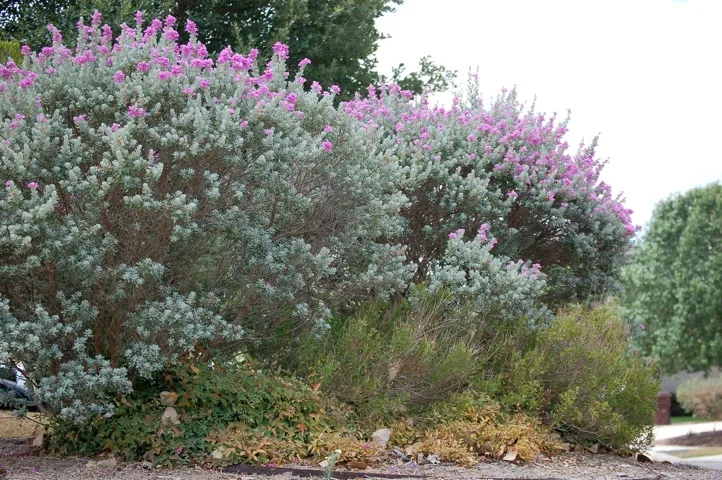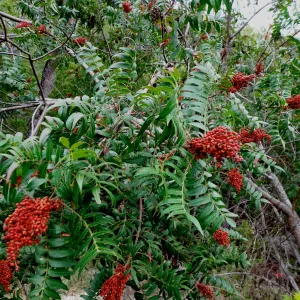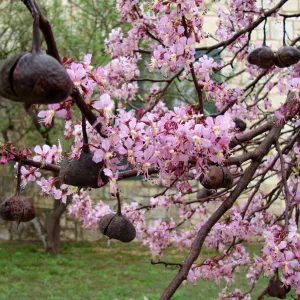by Carolyn Walden – Boerne Chapter, Native Plant Society of Texas
Published in Boerne Star on April 2, 2015

Let me introduce you to five more of my favorite drought-tolerant plants and provide a brief description and some of the added benefits of the plant, as promised in Chapters 1 and 2, published March 13 and 20, 2015. If you missed those chapters, here is how you can get specific information and pictures about the plants on the Native Plant Society (NPSOT) Boerne Chapter website http://www.npsot.org/wp/boerne/. Check out the Plant of the Month tab for 13 years of posters of flowers, shrubs, vines, trees and grasses that have been NICE! ™ (Natives Instead of Common Exotics) program featured plants. Click on a year to view the poster, which provides pictures and links to planting and care instructions for each of the featured plants. Also check out the Publications tab where you will find links to the NPSOT Monthly Newsletters, which include an article and pictures (in PDF version only) for that month’s featured plant and articles on gardening for butterflies and hummingbirds. The website also contains Recommended Native Plants for Boerne & Surrounding Counties (see the right sidebar on the Homepage for the links). Each of the plants below has been on a NICE! ™ poster; the month and year are at the end of each description.
Cenizo (Texas Sage) (Leucophyllum frutescens) is an evergreen shrub that grows 2-8 feet tall and as wide in full sun exposure. Planted in mass, cenizo makes a very nice hedge or screen. This purple flowering bush is commonly referred to as the barometer bush that flowers in response to changes in humidity in all seasons. Cenizo varieties available in the nurseries include a purple flowering form with green leaves (‘Green Cloud’) and a white flowering form with silver leaves (‘White Cloud’). Cenizo is a wildlife haven, providing nesting sites and cover, nectar and pollen for birds, bees and butterflies. Although generally deer resistant, it may be target for deer antler damage especially when young. Deer have taken the center out of several small to medium sized ones on our property; however the plants are recovering nicely inside cages. December 2012
Cedar Elm (Ulmus crassifolia) is a deciduous, medium-sized 30–60 ft tall shade tree with a single trunk and a narrow rounded to irregular crown. This tree grows moderately fast in full sun to part shade, in most soils and will tolerate poor drainage. Cedar elms have character; each seems to have its own unique shape, maybe a crooked trunk with rough bark that might have corky projections, droopy branches and tiny rough leaves, which turn yellow to gold in the fall. Select this native instead of non-native invasive trees such as Chinaberry and Chinese Pistache. Cedar Elm is a larval host plant for butterflies such as Mourning Cloak and Question Mark; and the seeds and buds are eaten by variety of small mammals and birds. March 2011

Prairie Flameleaf Sumac or Flameleaf sumac (Rhus lanceolata) is a deciduous ornamental shrub or single-trunked tree up to 10-20 feet tall, found on limestone and calcareous soils. The plant’s common name refers to its leaves, which turn brilliant shades of red and orange in the fall; so plant it in full sun to part shade where you can enjoy the fall color. A thick stand of them is dazzling; and yes these are the plants that provide so much of the color along Highways 46 and 16 as well as other Hill country roads. The tree might send out suckers if damaged by mowing, burning or grazing; avoid planting it where it is prone to damage or where suckers could be a problem. Flameleaf sumac is a good food source for bees, mammals and birds. The red berrylike fruits that ripen in the fall are a food source for over 20 species of birds. The leaves, branches, and red fruit can be used as a dye for wool. A few words of caution – sumacs are related to cashews, mangoes, poison ivy and poison sumac. Allergic skin reactions can occur in sensitive individuals who come in contact with the plant, particularly the oily surface of the fruit. Poison sumac, a native of East Texas, has white berries, making it easy to distinguish from the nonpoisonous, red-berried flameleaf sumac. The plant is considered to be deer-resistant. October 2003

Mexican Buckeye (Ungnadia speciosa) is a beautiful small ornamental, flowering shrub or small tree that grows rapidly to 8-30 ft. tall. It will grow in part shade or full sun in most well-drained soils. The fragrant, showy, pink spring flowers attract many useful insects including bees and butterflies; the fall color is a spectacular bright yellow. It provides a nesting site and shelter for several bird species. Warning: the leaves are toxic to livestock. April 2012
Desert Willow (Chilopsis linearis), a fast-growing, deciduous tree to 15-25 feet, is not an actual willow, but is so named because of its willow-like leaves and supple, flexible willow-like stems. It may be left as a bushy plant or carefully pruned into a tree form. Fragrant, showy, trumpet-shaped flowers bloom from April-September, especially following a rain, and attract butterflies, bees and hummingbirds. Plant Desert Willow instead of non-native, invasive flowering trees such as Chinese tallow, ligustrum, and Asian mimosa. Yes, there is a native mimosa – fragrant mimosa (Mimosa borealis). May 2012
Come see us at the Mostly Native Plant sale at the Kendall County Fairgrounds on Saturday April 4, 9AM-3PM. Early is better, to get more information and the best selection.
